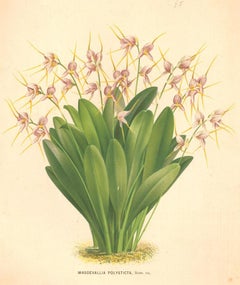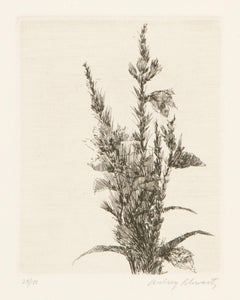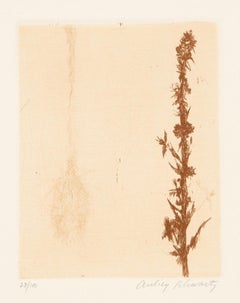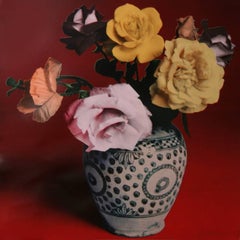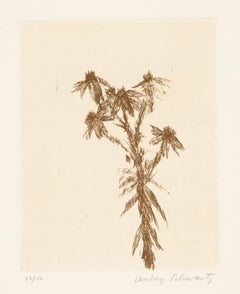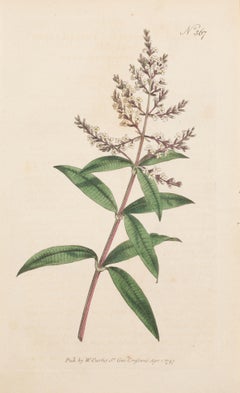Plant Still-life Prints
to
200
251
152
210
108
64
Overall Width
to
Overall Height
to
277
60
32
26
20
18
15
7
5
4
3
2
38
33
33
21
18
111
62
340
272
5
4
5
15
19
67
123
32
93
521
202
62
831
785
712
480
418
376
283
263
239
194
184
183
160
148
137
135
133
132
117
113
213
162
143
119
110
98
279
557
185
Art Subject: Plant
Peter De Pannemaeker - Mid 19th Century Lithograph, Masdevallia Polysticta
Located in Corsham, GB
A charming, highly collectable chromolithograph from the 19th century book L'Illustration horticole. Artist name and flower species printed in plate. On paper.
Category
Mid-19th Century Still-life Prints
Materials
Lithograph
Wild Flowers I, Modern Etching by Aubrey Schwartz
Located in Long Island City, NY
Aubrey Schwartz, American (1928 - 2019) - Wild Flowers I, Year: 1966, Medium: Etching, signed and numbered in pencil, Edition: 28/100, Image Size: 4.75 x 3.75 inches, Size: 14 x 10...
Category
1960s Modern Still-life Prints
Materials
Etching
Wild Flowers IX, Modern Etching by Aubrey Schwartz
Located in Long Island City, NY
Aubrey Schwartz, American (1928 - 2019) - Wild Flowers IX, Year: 1966, Medium: Etching, signed and numbered in pencil, Edition: 28/100, Image Size: 4.75 x 3.75 inches, Size: 14 x 1...
Category
1960s Modern Still-life Prints
Materials
Etching
Roses and Poppies in Spotted Vase (Red), Screenprint by Francesco Scavullo
Located in Long Island City, NY
Artist: Francisco Scavullo
Title: Roses and Poppies in Spotted Vase (Red)
Year: 1987
Medium: Screenprint, signed and dated l.r. in pencil
Edition: 73/75 (verso)
Size: 36 x 36 inches
...
Category
1980s Contemporary Still-life Prints
Materials
Screen
Wild Flowers VIII, Modern Etching by Aubrey Schwartz
Located in Long Island City, NY
Aubrey Schwartz, American (1928 - 2019) - Wild Flowers VIII, Year: 1966, Medium: Etching, signed and numbered in pencil, Edition: 28/100, Image Size: 4.75 x 3.75 inches, Size: 14 x...
Category
1960s Modern Still-life Prints
Materials
Etching
Vervain Three-leaved, Verbena triphylla Plate 367
Located in Columbia, MO
Vervain Three-leaved, Verbena triphylla Plate 367
1797
Hand-colored etching
Ed. 1st ed.
9 x 5.25 inches
Category
1790s Naturalistic Still-life Prints
Materials
Etching
Flowers of the Sea - Martine Goeyens - Digigraph - 2000s
Located in Roma, IT
Flowers Of The Sea is an original digigraph realized by Martine Goeyens in the 2000s.
The artwork is hand-signed in pencil by the artist on the lower right. Hand-retouched by the art...
Category
21st Century and Contemporary Contemporary Still-life Prints
Materials
Digital
Flowers, Lithograph by V Beffa
Located in Long Island City, NY
Flowers
V. Beffa
Date: circa 1977
Lithograph on Arches, Signed and numbered in pencil
Edition of 250
Image Size: 24 x 17.5 inches
Size: 29.5 in. x 21.5 in. (74.93 cm x 54.61 cm)
Category
1970s Still-life Prints
Materials
Lithograph
Pink Camellia, Photorealist Screenprint on Paper by Lowell Nesbitt
Located in Long Island City, NY
Photorealist flower screenprint by American artist Lowell Blair Nesbitt, signed and numbered in pencil.
Pink Camellia from the Stamps Series
Lowell Blair Nesbitt, American (1933–199...
Category
1980s Photorealist Still-life Prints
Materials
Screen
Untitled 69
Located in New York, NY
Cyanotype (Unique)
Signed, titled, and dated in pencil, verso
This artwork is offered by ClampArt, located in New York City.
These cyanotype prints of botanical specimens were made ...
Category
1990s Contemporary Still-life Prints
Materials
Color
Les Fleurs-Limited Edition Print, Artist Signature is Illegible
Located in Chesterfield, MI
Limited Edition Print (35/80). Pencil-signed by the artist (signature is illegible). Measures 14.75 x 11 inches and is unframed. The print is in Very Good Condition.
Category
Late 20th Century Still-life Prints
Materials
Lithograph
$200 Sale Price
20% Off
Happy Plant
Located in Palm Springs, CA
Signed and numbered from the edition of 10. Printed on chine colle.
Yuji Hiratsuka was born 1954 in Osaka, Japan. In 1985 he moved to the United States to pursue graduate degrees in...
Category
2010s Contemporary Still-life Prints
Materials
Intaglio
Jean Bardon — Dahlia, Color Etching
By Jean Bardon
Located in Palm Springs, CA
The formality, ornamental qualities and boldness of botanical art strongly influence Bardon's art. It is easy to see her inspiration in the patterns, line and simplicity of form found in Asian art. Some prints also include gold leaf, recalling the extensive use of gold on Japanese folding screens, and in early Renaissance painting...
Category
21st Century and Contemporary Contemporary Still-life Prints
Materials
Etching, Aquatint
Woodland Scene, Tim Southall, Bright Art, Affordable Art, Contemporary Print
By Tim Southall
Located in Deddington, GB
Tim Southall
Woodland Scene
Limited Edition 6 Colour Silkscreen Print
Edition of 25
Sheet Size: H 46cm x W 64cm x D 0.1cm
Sold Unframed
Please note that insitu images are purely an i...
Category
21st Century and Contemporary Contemporary Landscape Prints
Materials
Paper, Screen
Western Lullabies N°6, Art print, Floral, Plants, Flowers art, Art on paper
Located in Deddington, GB
Forsyth’s work conveys his love of the drama of nature, seeking to expand the beauty of natural forms that we sometimes overlook in everyday life showing an extra dimension in his wo...
Category
2010s Contemporary Still-life Prints
Materials
Archival Ink
Wild Flowers VII, Modern Etching by Aubrey Schwartz
Located in Long Island City, NY
Aubrey Schwartz, American (1928 - 2019) - Wild Flowers VII, Year: 1966, Medium: Etching, signed and numbered in pencil, Edition: 28/100, Image Size: 4.75 x 3.75 inches, Size: 14 x 1...
Category
1960s Modern Still-life Prints
Materials
Etching
Red Rose, Photorealist Screenprint by Lowell Nesbitt
Located in Long Island City, NY
Artist: Lowell Blair Nesbitt, American (1933 - 1993)
Title: Red Rose
Year: 1980
Medium: Screenprint, signed and numbered in pencil
Edition: 200
Image Size: 30...
Category
1980s American Realist Still-life Prints
Materials
Screen
Iris, Amaryllis, Lilies
By Jean Bardon
Located in Palm Springs, CA
The formality, ornamental qualities and boldness of botanical art strongly influence Bardon's art. It is easy to see her inspiration in the patterns, line and simplicity of form found in Asian art. Some prints also include gold leaf,
recalling the extensive use of gold on Japanese folding screens, and in early Renaissance painting...
Category
21st Century and Contemporary Contemporary Still-life Prints
Materials
Etching, Aquatint
Untitled S25
Located in New York, NY
Cyanotype (Unique)
Signed, titled, and dated in pencil, verso
This artwork is offered by ClampArt, located in New York City.
These cyanotype prints of botanical...
Category
1990s Contemporary Still-life Prints
Materials
Color
Wild Flowers II, Modern Etching by Aubrey Schwartz
Located in Long Island City, NY
Aubrey Schwartz, American (1928 - 2019) - Wild Flowers II, Year: 1966, Medium: Etching, signed and numbered in pencil, Edition: 28/100, Image Size: 4.75 x 3.75 inches, Size: 14 x 1...
Category
1960s Modern Still-life Prints
Materials
Etching
Craggula Tree, Crassula cotyledon Plate 384
Located in Columbia, MO
Craggula Tree, Crassula cotyledon Plate 384
1797
Hand-colored etching
Ed. 1st ed.
9 x 5.25 inches
Category
1790s Naturalistic Still-life Prints
Materials
Etching
Brooklyn Botanical Gardens I; Brooklyn Botanical Gardens II (Diptych)
By Hugh Kepets
Located in New York, NY
Hugh Kepets has lived and worked in New York for the past three decades. He has had numerous one-person shows of his paintings, drawings and prints in New York, Chicago, Boston, Phil...
Category
1970s Contemporary Still-life Prints
Materials
Lithograph
$960 Sale Price
46% Off
Three Irises on Green, Floral Photorealist Screenprint by Lowell Nesbitt
Located in Long Island City, NY
Artist: Lowell Blair Nesbitt, American (1933 - 1993)
Title: Three Irises on Green
Year: 1980
Medium: Serigraph, signed and numbered in pencil
Edition: AP 40
Image Size: 20 x 44 inche...
Category
1980s American Realist Still-life Prints
Materials
Screen
Flora Italiana ( Waratah Red ) - large format botanical still life photograph
Located in San Francisco, CA
Original large format still life photograph from Linda Rosewall's series "Flora Italiana", an intensely beautiful body of works exploring the botanical splendor of Italian flowers with highly detailed captures
Flora Italiana ( Waratah Red )
64 x 48 inches (162 x 122cm)
signed edition of 7
40 x 30 inches (102 x 76cm)
signed edition of 25
archival fine art pigment print
signed & numbered by artist on label
custom/larger sizes are available on request
___________________
About the artist
Linda Rosewall’s artistic path was cemented during her childhood. She was inspired by her farther, an accomplished musician and composer who raised his six children as a performing family act.
The experience of traveling the United States and Canada in a small airplane piloted by her father provided the opportunity for Linda to capture these moments on her small Kodak Instamatic Camera.
At the age of 18, she enrolled at Columbia College of Fine Arts Chicago. During her studies, Linda apprenticed under photographer Norman Bilisko and later worked with Dennis Manarchy...
Category
21st Century and Contemporary Contemporary Color Photography
Materials
Archival Ink, Archival Paper, Photographic Paper, Giclée, Archival Pigment
Flora Italiana (Narcissus Poetic) - large format botanical still life photograph
Located in San Francisco, CA
Original large format still life photograph from Linda Rosewall's series "Flora Italiana", an intensively beautiful body of works exploring the botanica...
Category
21st Century and Contemporary Contemporary Color Photography
Materials
Archival Ink, Archival Paper, Photographic Paper, Giclée
Ananus Sclvestris ( Pineapple ) N. 110 mezzotint engraving with hand coloring
Located in Paonia, CO
Johann Wilhelm Weinmann
Ananus Sclvestris ( Pineapple ) N. 110
mezzotint engraving with hand coloring
paper size 15.50 x 9.50
image size 13 x 8.25
Ananus Sclvestris ( Pineapple ) N....
Category
1730s Still-life Prints
Materials
Mezzotint
Bluebells and Snowdrops diptych
By Lucy Routh
Located in Deddington, GB
Bluebells and Snowdrops diptych
Overall sheet size : H80 x W80
Lucy Routh – Bluebells
Inspired by nature and the beauty found in everyday objects. I combine traditional still life s...
Category
2010s Minimalist Still-life Prints
Materials
Paper, Giclée
Red Poppies, Contemporary Floral Screenprint by Donald Sultan
Located in Long Island City, NY
Artist: Donald Sultan, American (1951 - )
Title: Red Poppies
Year: 1989
Medium: Screenprint, signed and numbered in pencil
Edition: 125
Image Size: 12 x 12...
Category
1980s Contemporary Still-life Prints
Materials
Screen
Marvel of Peru Common, Mirabilis jalapa Plate 371
Located in Columbia, MO
Marvel of Peru Common, Mirabilis jalapa Plate 371
1797
Hand-colored etching
Ed. 1st ed.
9 x 5.25 inches
Category
1790s Naturalistic Still-life Prints
Materials
Etching
Botanical from "The Ladies' Flower Garden of Ornamental Annuals" Yellow Loasa
Located in Austin, TX
Artist: Lady Jane Webb Loudon (British, 1800 - 1858)
9.5 x 8 in. page.
12 x 14 in. frame.
A "chromolithographic" plate from The Ladies' Flower-Garden of Ornamental Annuals. By Mrs. ...
Category
Mid-19th Century Still-life Prints
Materials
Paper, Lithograph
Red Lilies, Photorealist Lithograph by Jochen Labriola
By Jochen Labriola
Located in Long Island City, NY
Artist: Jochen Labriola, American
Title: Red Lilies
Year: circa 1975
Medium: Lithograph, signed and dedicated l.r.
Size: 34 x 25 in. (86.36 x 63.5 cm)
Category
1970s American Realist Still-life Prints
Materials
Lithograph
Isn't This Still Life
Located in Berkeley, CA
Color aquatint, sugarlift and spitbite aquatints.
Paper Size: 29.5” x 22.75”
Edition of 30
Category
2010s Still-life Prints
Materials
Etching
Violet Monochrome, Lowell Nesbitt
Located in Fairfield, CT
Artist: Lowell Nesbitt (1933-1993)
Title: Violent Monochrome
Year: 1980
Edition: 56/200, plus proofs.
Medium: Silkscreen on Arches paper
Size: 31.5 x 31 inches
Condition: Good
Inscri...
Category
1980s Pop Art Landscape Prints
Materials
Screen
$876 Sale Price
20% Off
Three Irises on Yellow, Photorealist Screenprint by Lowell Nesbitt
Located in Long Island City, NY
Artist: Lowell Blair Nesbitt, American (1933 - 1993)
Title: Three Irises on Yellow
Year: 1980
Medium: Screenprint, signed and numbered in pencil
Edition: 200
Image Size: 15.25 x 36 i...
Category
1980s American Realist Still-life Prints
Materials
Screen
$680 Sale Price
20% Off
Untitled L15
Located in New York, NY
Cyanotype (Unique)
Signed, titled, and dated in pencil, verso
This artwork is offered by ClampArt, located in New York City.
These cyanotype prints of botanical...
Category
1990s Contemporary Still-life Prints
Materials
Color
Untitled F24
Located in New York, NY
Cyanotype (Unique)
Signed, titled, and dated in pencil, verso
This artwork is offered by ClampArt, located in New York City.
These cyanotype prints of botanical...
Category
1990s Contemporary Still-life Prints
Materials
Color
White Iris on Purple, Photorealist Screenprint by Lowell Nesbitt
Located in Long Island City, NY
Artist: Lowell Blair Nesbitt, American (1933 - 1993)
Title: White Iris on Purple
Year: 1981
Medium: Screenprint, signed and numbered in pencil
Edition: 200
Image Size: 35 x 24 inches...
Category
1980s American Realist Still-life Prints
Materials
Screen
Buds
By Jack Beal
Located in Fairlawn, OH
Buds
Color lithograph, 1980
Signed, titled, and editioned in pencil by the artist
Publisher: Art Matters
Printer: Bud Shark, Shark's Ink, Lyons, CO
Condition: Excellent
Image: 31-1/8 x 41-1/4" (79 x 104.7 cm.)
"An Abstract Expressionist when he left the Art Institute of Chicago in 1956, Beal has since become a dedicated realist who sees art as a potentially powerful moral force. He has great regard for Platonic ideals of truth, beauty, and goodness, and admires both the realism of seventeenth-century Dutch painting and the compositional authority of Renaissance art. Since moving to New York in the late 1950s with his wife, painter Sondra Freckelton, Beal has painted still lifes, portraits, and landscapes, although in recent years his most ambitious undertakings have been large-scale allegories and myths. In describing his approach, Beal calls himself a "life painter" and says he is committed to human over aesthetic concerns. Yet his intricate complexes of figures and surface patterns, along with his adroit handling of space, reveal his sophisticated, accomplished sense of composition.
Virginia M. Mecklenburg
Biography
Jack Beal (1931-2013) was born and raised in Richmond, Virginia. He briefly attended the College of William and Mary, studying biology, but dropped out after two years. A decision to take evening art classes lead to his attending the Art Institute of Chicago, where he studied from the old masters in the Institute’s collection and with Isobel Steele MacKinnon, a student of Hans Hoffman. His classmates there included Red Grooms, Richard Estes, Claes Oldenberg and Robert Barnes, and while abstract expressionism remained “the only valid way to paint,” it was a style that all would eventually reject. In 1956 Beal left the Art Institute and moved to New York with the aim of finding success as a painter, eventually becoming one of the first artists to settle in the SoHo neighborhood.
A turning point came in 1962 when, spending the summer in upstate New York, Beal decided to begin painting outdoors. Dissatisfied with abstract painting, he “wanted to give Art one more try” and in working from nature “fell in love with painting all over again.” Over the next few years Beal worked toward a balance between expressionistic paint handling and realistic, narrative pictures. Clement Greenberg’s pronouncement around this time, that the figure was no longer a valid subject was taken as a challenge by many artists, Beal included. His subsequent adoption of the female nude - modeled by his wife, the artist Sondra Freckelton - was a break-through. Though the paintings retained the sensuousness of his earlier canvases, the rigorous formality of their composition and the masterful treatment of light and shadow offered a new approach to realist painting. Indeed, Beal was not alone in this transformation; friends and colleagues in New York were coming to similar conclusions and the group, who included painters such as Philip Pearlstein, Alfred Leslie, Yvonne Jacquette, Alex Katz, Jack Tworkov, Nell Blaine and Fairfield Porter, would eventually be considered the ‘New Realists.’
With the resurgence of figurative painting, Beal distinguished himself for his skillful handling of color and modeling as well as what was later described as his “pushing of representational forms to their interface with abstraction”. Through the later half of the 1960s, while his subject matter remained unchanged, his paintings were increasingly given over to wide areas of flat color. In 1969, he exhibited a series of Table Paintings which, with their hard-edge style and near complete abstraction of the form, were a radical departure for Beal. So radical in fact, he was accosted by fellow realist painters Alfred Leslie and Sidney Tillim, who berated him “for betraying realism and betraying [himself], for moving away from ‘the true path’.” The incident had its intended effect and Beal did return to a more naturalistic and humanistic style, eventually abandoning the nude in favor of increasingly allegorical portraits. In 1974, the United States General Services Administration commissioned Beal to produce a series of murals for the U.S. Department of Labor headquarters in Washington D.C. The result was The History of Labor, four, 12 x 13 foot paintings in the vein of George Caleb Bingham, each illustrating a century of American development.
Following the completion of the murals in 1977, Beal continued to make use of narrative in his paintings, with portraiture and self-portraiture as a means of exploring moral and didactic themes. He and Sondra had purchased an old mill in upstate New York in 1974 and after extensive renovations, it became their permanent residence. Unsurprisingly, many of his later paintings are pastoral scenes based on his rural surroundings or still lives including flowers which they grew on the property. In 1986, Beal was commissioned by the Art in Transit Initiative to create a large-scale mural as part of the redevelopment of the Times Square Subway Station. The proposed mosaic mural, The Return of Spring, took over fifteen years to complete, with the two, 7 x 20 foot sections finally installed in 2001 and 2005. Together they update the Greek myth of Persephone with a New York setting, showing her abduction by Hades, initiating the arrival of winter, and her release, bringing the bountiful return of spring.
Beal was a founder of the Artist’s Choice Museum, New York and the New York Academy of Art as well as the recipient of numerous grants and awards, including honorary degrees from the Art Institute of Boston and the Hollins College...
Category
1980s Contemporary Still-life Prints
Materials
Lithograph
$1,200
"Campions, " Lithograph Still Life by Sheila Stafford
By Sheila Stafford
Located in Milwaukee, WI
"Campions" is an original color lithograph by Sheila Stafford. The artist signed the piece in the lower right and titled it and wrote the edition number (24/24) in the lower left - b...
Category
1980s Still-life Prints
Materials
Lithograph
The White Prince-Poster. New York Graphic Society. Lithographed in USA
Located in Chesterfield, MI
PAUL DE LONGPRÉ (French, 1855-1911)
The White Prince
Poster/Print
22 x 17 in. Unframed
Plate signed
Copyright New York Graphic Society. Lithographe...
Category
Late 20th Century Still-life Prints
Materials
Lithograph
Charlie Davies, Agapanthus, Limited Edition Floral Print, Affordable Art
Located in Deddington, GB
Agapanthus [2021]
Limited Edition
Flowers
Soft Etching
Edition number 100
Image size: H:29.5 cm x W:29.5 cm
Complete Size of Unframed Work: H:50 cm x W:50 cm x D:0.1cm
Sold Unframed
...
Category
21st Century and Contemporary Contemporary Still-life Prints
Materials
Paper, Etching
Toad-flax Clammy, Antirrhinum viscosum Plate 368
Located in Columbia, MO
Toad-flax Clammy, Antirrhinum viscosum Plate 368
1797
Hand-colored etching
Ed. 1st ed.
9 x 5.25 inches
Category
1790s Naturalistic Still-life Prints
Materials
Etching
Zen Minimalist Flowers Etching American Modernist Ed Baynard Pop Art Print
By Ed Baynard
Located in Surfside, FL
ED BAYNARD (American, 1940-2016)
Flowers, Flowers in a Vase, Etching.
1979/1980,
Hand signed, dated l.r.,
Hand numbered from small edition 12/24,
Dimensions: 23 by 19 in. Framed 25 by 21 in
Born in Washington, D.C. in 1940. Raised in Washington, D.C. and newly graduated from high school, he flew to Europe living off and on in Paris and London. During this time, he designed costumes for Jimi Hendrix, worked as a graphic designer for the Beatles as well as Elizabeth Taylor and Richard Burton. Returning to New York, he dedicated his life to art after a surprise success with his first show in 1971 at the Willard Gallery in NYC. Ed's images are Zen-like in their simplicity and grace rendered in a flat, graphic style that recalls Japanese Ukiyo-e prints. His watercolors are luminous, like the rest of his representations regardless of the medium. The Japanese inspired ukiyo-e style woodblock prints and lithograph works he created at Tyler Graphics in 1980 contain a 20th century "floating world" sensibility. Ed's wish was to bring harmony, color, and a meditative stillness to this chaotic planet. He did so in a gentle and powerful way, always as an expression of his deep gratitude for the love and beauty, friendship, and concerns he held dearest. His first solo exhibition was in 1971 at New York's legendary Willard Gallery on the recommendation of Agnes Martin. Baynard went on to have exhibitions at galleries including Betty Parsons Gallery, New York (1973); Marian Goodman Gallery, New York (1977); John Berggruen Gallery, San Francisco (1980); and Barbara Gladstone Gallery, New York (1980/81).. Baynard manages to retain a simplicity of form inspired by a love of Japanese Woodblock prints. His new works reflect the same poetry of his earlier paintings, retaining his stylized compositions with their Zen like minimalism and Oriental calm, along with a new sense of rhythm and movement. Baynard uses familiar themes such as flowers, plants, pots, and vases, incorporating them into his delicate watercolor still lifes, thus creating stunning visual feasts. He was included in the 1972 Landscape exhibition at MoMA NY alone with other luminaries James Boynton...
Category
1980s American Modern Still-life Prints
Materials
Etching
Art of the 80's New York Exhibition-Poster
Located in Chesterfield, MI
PEMA
Art of the 80's, New York Exhibition-Poster. Measures 36 x 24 inches Unframed. Plate Signed. Fair/Distressed Condition.
Category
1980s Still-life Prints
Materials
Lithograph
$100 Sale Price
20% Off
Amaryllis Waved-flowerd, Amaryllis undulatea Plate 369
Located in Columbia, MO
Amaryllis Waved-flowerd, Amaryllis undulatea Plate 369
1797
Hand-colored etching
Ed. 1st ed.
9 x 5.25 inches
Category
1790s Naturalistic Still-life Prints
Materials
Etching
Corn-flag Copper coloured, Gladiolus securiger Plate 383
Located in Columbia, MO
Corn-flag Copper coloured, Gladiolus securiger Plate 383
1797
Hand-colored etching
Ed. 1st ed.
9 x 5.25 inches
Category
1790s Naturalistic Still-life Prints
Materials
Etching
Flower Field, Silkscreen by Nadine Prado
By Nadine Prado
Located in Long Island City, NY
Flower Field 4
Nadine Prado, Mexican/French (1940)
Date: 1979
Screenprint, Signed and numbered in Pencil
Edition of 300
Size: 32 x 32 in. (81.28 x 81.28 cm)
Category
1970s Contemporary Still-life Prints
Materials
Screen
Quiet Sunday (Blue), Hand-painted Impressionist Lithograph by Wayne Ensrud
By Wayne Ensrud
Located in Long Island City, NY
A unique hand-painted lithograph of a colorful Bouquet of Flowers by Wayne Ensrud, American (1934).
Quiet Sunday (Blue)
Wayne Ensrud, American (1934)
Date: 1980
Hand-Painted Lithogra...
Category
1980s Impressionist Still-life Prints
Materials
Acrylic, Lithograph
"Leaves & Berries" giclée print after ca. 1950s original watercolor and collage
Located in Milwaukee, WI
14.75 x 17.75 inches, artwork
22.88 x 25.75 inches, frame
Born in 1908, Sylvia Spicuzza was the daughter of noted painter Francesco Spicuzza. Sylvia devoted herself to teaching art ...
Category
1950s Modern Still-life Prints
Materials
Giclée, Watercolor
Going Home with Etching and Aquatint on Paper, Print by Phil Greenwood
Located in Deddington, GB
Going Home By Phil Greenwood [2021]
Going Home by artist Phil Greenwood is a limited edition print made using aquatint and etching. A figure is depicted walking through dense woodla...
Category
2010s Abstract Landscape Prints
Materials
Etching
Evenbode Valley, Ascott-V-Wychwood, Oxfordshire, Art print, Nature, Landscape
Located in Deddington, GB
Evenbode Valley, Ascott-V-Wychwood by Judith Yarrow depicts a traditional Autumn scene showing a row of bare trees on the riverside. The colours are drawn from soft yellows, greens, ...
Category
2010s Contemporary Landscape Prints
Materials
Giclée, Paper
Lillias (9 Piece Installation)
By Ray Charles White
Located in Long Island City, NY
Artist: Ray Charles White (Canadian 1961 - )
Title: Lillias
Year: 2005
Medium: Screenprinted Enamel on Anodized Aluminum (Nine Panels), each signed ...
Category
21st Century and Contemporary Contemporary Still-life Prints
Materials
Aluminum
Anemone
Located in New York, NY
ABOUT THIS ARTIST: In rich, cinematic reds and browns, vivid yellows, and muted neutral shades, Adrian Samson’s photographs seduce viewers into a radiant, chromatic universe. With a ...
Category
2010s Black and White Photography
Materials
Photographic Paper
“Still Life of Flowers” Poster, Copyright 1969 New York Graphic Society
Located in Chesterfield, MI
JAN BRUEGHEL, THE ELDER (Flemish, 1568-1625). Poster/Print. Measures 38 x 29 in. Unframed. Copyright 1969 New York Graphic Society. Printed in USA. Fair/Mildly Distressed Condition- ...
Category
1960s Still-life Prints
Materials
Screen
Zen Minimalist Flowers Etching American Modernist Ed Baynard Pop Art Print
By Ed Baynard
Located in Surfside, FL
ED BAYNARD (American, 1940-2016)
Flowers, Flowers in a Vase, Etching.
1979/1980,
Hand signed, dated l.r.,
Hand numbered from small edition 12/24,
Dimensions: 23 by 19 in. Framed 25 by 21 in
Born in Washington, D.C. in 1940. Raised in Washington, D.C. and newly graduated from high school, he flew to Europe living off and on in Paris and London. During this time, he designed costumes for Jimi Hendrix, worked as a graphic designer for the Beatles as well as Elizabeth Taylor and Richard Burton. Returning to New York, he dedicated his life to art after a surprise success with his first show in 1971 at the Willard Gallery in NYC. Ed's images are Zen-like in their simplicity and grace rendered in a flat, graphic style that recalls Japanese Ukiyo-e prints. His watercolors are luminous, like the rest of his representations regardless of the medium. The Japanese inspired ukiyo-e style woodblock prints and lithograph works he created at Tyler Graphics in 1980 contain a 20th century "floating world" sensibility. Ed's wish was to bring harmony, color, and a meditative stillness to this chaotic planet. He did so in a gentle and powerful way, always as an expression of his deep gratitude for the love and beauty, friendship, and concerns he held dearest. His first solo exhibition was in 1971 at New York's legendary Willard Gallery on the recommendation of Agnes Martin. Baynard went on to have exhibitions at galleries including Betty Parsons Gallery, New York (1973); Marian Goodman Gallery, New York (1977); John Berggruen Gallery, San Francisco (1980); and Barbara Gladstone Gallery, New York (1980/81).. Baynard manages to retain a simplicity of form inspired by a love of Japanese Woodblock prints. His new works reflect the same poetry of his earlier paintings, retaining his stylized compositions with their Zen like minimalism and Oriental calm, along with a new sense of rhythm and movement. Baynard uses familiar themes such as flowers, plants, pots, and vases, incorporating them into his delicate watercolor still lifes, thus creating stunning visual feasts. He was included in the 1972 Landscape exhibition at MoMA NY alone with other luminaries James Boynton...
Category
1980s American Modern Still-life Prints
Materials
Etching
Heath Recurved, Erica retorta Plate 362
Located in Columbia, MO
Heath Recurved, Erica retorta Plate 362
1797
Hand-colored etching
Ed. 1st ed.
9 x 5.25 inches
Category
1790s Naturalistic Still-life Prints
Materials
Etching
Brunfelsia American, Brunfelsia americana Plate 393
Located in Columbia, MO
Brunfelsia American, Brunfelsia americana Plate 393
1797
Hand-colored etching
Ed. 1st ed.
9 x 5.25 inches
Category
1790s Naturalistic Still-life Prints
Materials
Etching
------- Shining-leaved, Salvia formosa Plate 376
Located in Columbia, MO
—– Shining-leaved, Salvia formosa Plate 376
1797
Hand-colored etching
Ed. 1st ed.
9 x 5.25 inches
Category
1790s Naturalistic Still-life Prints
Materials
Etching
------- Pyramidal, ------- Pyramidalis Plate 366
Located in Columbia, MO
—–---Pyramidal, -------Pyramidalis Plate 366
1797
Hand-colored etching
Ed. 1st ed.
9 x 5.25 inches
Category
1790s Naturalistic Still-life Prints
Materials
Etching
Cyrilla Scarlet-flowered, Cyrilla pulchella Plate 374
Located in Columbia, MO
Cyrilla Scarlet-flowered, Cyrilla pulchella Plate 374
1797
Hand-colored etching
Ed. 1st ed.
9 x 5.25 inches
Category
1790s Naturalistic Still-life Prints
Materials
Etching
Recently Viewed
View AllMore Ways To Browse
Nandi Bull
New England Church Painting
Newfoundland Dog Art
Newport Rhode Island Paintings
Norman C Black Painting
Norman Prescott
Norval Morrisseau
Notorious Big
Nude Scape
O T Clark
Oasis Vintage Poster
Octavius Clark
Oil Painting Constantinople
Oil Painting Dog Sleeping
Oil Painting In Bone
Oil Painting Steamship
Oil Painting With Computer
Oil Thomas Creswick
